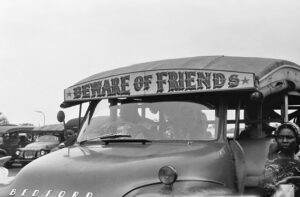… The “Tso lorry” era
By Nannah Aba OFORI -DANKWA
Before the buses, during the era of trains, the Bedford trucks – casually known as the “bone shaker”, Arrow Glass, and Tso Lorry amongst others – were the major means of transportation in Ghana.
let’s take a nostalgic trip down memory lane to the days of the iconic “Tso Lorry” – those wooden cars with no windows that were a staple of Ghanaian transportation in the past.
In the late 1930s, Bedford trucks aka bone shaker emerged as a common sight on Ghana’s roads, quickly becoming indispensable for transporting cocoa, salt, and various goods to railway stations, even before properly tarred roads were widespread.
Renowned for their robust diesel engines and sturdy steel frames, Bedfords earned a reputation for reliability and durability akin to that of tractors.
Typically owned by affluent traders, both men and women, these vehicles underwent customization by skilled carpenters.
Carpenters were tasked with constructing the box, seats, and roof—tarred to withstand rain—and adding canvas flaps for protection against the elements.
Despite navigating pothole-ridden roads and pathways, Bedfords proved remarkably resilient, withstanding heavy wear and tear while remaining easy to maintain and seldom experiencing breakdowns.
Captions of Life: “Tso Lorry” memories
One of the most memorable aspects of the Tso Lorry experience was the captions painted on the back of each vehicle. These captions ranged from humorous and witty to thought-provoking and philosophical.
Some favorites included “No Time to Die,” “Beggar Has No Choice,” “Poor No Fiend,” and “God’s Time is the Best.” Each caption offered a glimpse into the daily lives, struggles, and aspirations of Ghanaian commuters.

Seating in the Tso Lorry was on simple wooden benches, fostering friendships and connections among passengers who shared stories, jokes, and sometimes even snacks. The lack of windows meant that we were fully immersed in our surroundings, forging a deep connection to the landscapes and communities we traveled through.
Evolution of Ghana’s Road Transport
From good old Bedford trucks to luxurious cross-country vehicles and saloons, Ghana’s automobile and road transport sectors have seen it all from years preceding the country’s republican status till date.
Vehicles made their appearance in the Gold Coast at the turn of the 19th century, not so long after they took to the road in Europe in the 1890s. According to statistics from the Driver and Vehicle Licensing Authority (DVLA), Ghana’s roads are now responsible for well over 3.2 million cars.
Trotro: The heartbeat of urban mobility
The narrative of Ghana’s public transport over the past six decades would be incomplete without mentioning the ubiquitous ‘trotro’. Legend has it that the term ‘Tro-Tro’ originates from the Ga word “tro,” which translates to three pence, a reference to the penny coin used during the colonial era. Back then, passengers were charged three pence per trip, hence the moniker “tro-tro,” a name that has endured through the years. Trotro encompassed any vehicle capable of ferrying passengers – ranging from buses to minibusses, including cargo vans repurposed into passenger buses and the sturdy Bedford trucks, affectionately dubbed ‘bone shakers’ (now prohibited for passenger transportation).
Despite its indispensable role in facilitating mobility, the trotro experience can often be daunting, even for the most resilient urban dweller. Journeys are marked by frequent stops and starts, uncomfortable seating arrangements, incessant blaring of horns, and aggressive – sometimes reckless – driving. While fares remain relatively affordable, they can skyrocket during fuel price hikes or at the discretion of transport unions. Additionally, some trotro vehicles pose safety hazards as they have surpassed their roadworthy lifespan.
However, entertainment is not hard to find on a ‘trotro’. A trotro could be a stress reliever as it enables you to experience the sales gimmicks of vendors and the wit of comedians and sometimes ‘medical evangelists’. Most of the time, before a vehicle reaches its destination, a few passengers exchange their money for goods.
GPRTU: Regulating transportation for decades
In recent times, the Ghana Private Road Transport Union (GPRTU) has played a pivotal role in the transportation sector. Established in 1972, the GPRTU has been instrumental in regulating and organizing transportation services across the country. With its extensive network of members, the GPRTU ensures the provision of safe, reliable, and affordable transportation for Ghanaians nationwide.
Digital Transformation: Revolutionising travel with OYA
The GPRTU’s embrace of digital transformation in recent years has ushered in a new era of convenience and efficiency for Ghanaians traveling across the country. Through strategic partnerships with the digital transport solutions company OYA, passengers now have unprecedented control over their travel experiences.

The ability to book tickets online not only saves valuable time but also allows for better planning and budgeting, easing the strain on commuters’ pockets. Moreover, the option to join buses mid-route and report careless driving provides passengers with a sense of security and empowerment, ensuring safer journeys for all.
The feature allowing passengers to select seats adds an extra layer of comfort and personalization to the travel experience, while the innovative passenger speedometer enables travellers to monitor the driver’s speed, promoting accountability and adherence to safety standards.
Additionally, the seamless sharing of trip experiences fosters a sense of community and transparency within the transportation system, ultimately contributing to improved overall satisfaction and trust among passengers. This digital revolution not only enhances convenience but also demonstrates the GPRTU’s commitment to prioritizing the well-being and financial interests of Ghanaian commuters.
As we journey through Ghana’s transportation history, from the iconic Tso Lorries to the bustling trotros and the digital innovations of today, one thing remains clear – transportation is more than just a means of getting from point A to point B. It’s a reflection of our culture, our resilience, and our ability to adapt and evolve with the times.
Today the GPRTU has built a transportation system that not only connects us but also enhances our lives and communities.0










